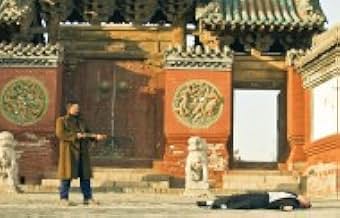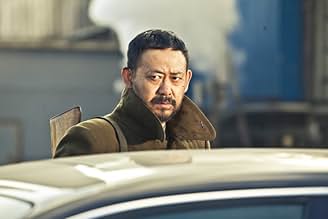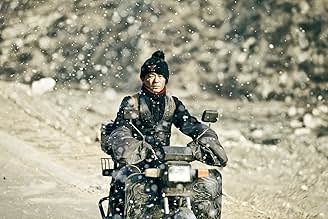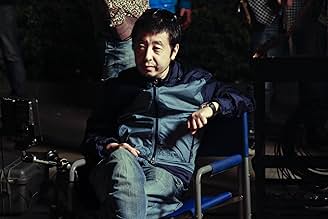Four independent stories set in modern China about random acts of violence.Four independent stories set in modern China about random acts of violence.Four independent stories set in modern China about random acts of violence.
- Awards
- 18 wins & 12 nominations total
Featured reviews
This film exposes the difficulties of a few characters in various Chinese provinces - people of average circumstances just trying to get by. Their stories are based on true events.
This film is suitably shocking in many ways in exposing not only the difficulties of the characters in focus but also the extreme reactions some of them have in dealing with their circumstances. The most creepy aspect is the absence of any authorities or help given to those who need it. This was intended by director Jia Zhang-Ke to expose modern life in China.
While there are powerful scenes in this movie, it seemed confusing at times and not fully coherent and a bit long at over two hours. But credit can be given to the boldness of exposing so much in a totalitarian regime. - dbamateurcritic
This film is suitably shocking in many ways in exposing not only the difficulties of the characters in focus but also the extreme reactions some of them have in dealing with their circumstances. The most creepy aspect is the absence of any authorities or help given to those who need it. This was intended by director Jia Zhang-Ke to expose modern life in China.
While there are powerful scenes in this movie, it seemed confusing at times and not fully coherent and a bit long at over two hours. But credit can be given to the boldness of exposing so much in a totalitarian regime. - dbamateurcritic
One additional star for the topic that few has tried to film.
In about ten or twenty years, these 120 minutes of social depicting will be one of the very rare and precious visual stories for people to understand and entertain what is going on in the first ten years of the 21st century China. It offers a prospective with some interesting details that makes sense to the westerners or maybe its fellow countrymen in the future. But it doesn't really add up for the people living in China nowadays, or at least, the details are not enough.
Stories are too short that they can barely touch the real psychology that the Chinese laborers are having today. I'm not sure whether it is something that the director fails to do or he is not allowed to do. For example, there are lots of complexities existing between a complaining Shanxi miner and a mad murderer. Throughout the first story, the only real attempt Dahai, who has learned the laws and has close relatives living in the city, has made to disclose the corruption is a mail letter without a specific address. This is far away from the countless efforts that a Chinese miner would make before he explode himself with the illegal riches. To me, the efforts, the struggles, and the final desperate in Dahai's mind are the most interesting parts of the story. However, nothing really happens in the movie. The result is that, Dahai seems more like a legendary cowboy coming from a classic American western movie than a struggling Chinese worker who has relatives to care about.
It touches the social issues we are all witnessing in China today, it is entertaining and somewhat heroic, but it fails to restore the story into reality, let alone into a provoking level.
In about ten or twenty years, these 120 minutes of social depicting will be one of the very rare and precious visual stories for people to understand and entertain what is going on in the first ten years of the 21st century China. It offers a prospective with some interesting details that makes sense to the westerners or maybe its fellow countrymen in the future. But it doesn't really add up for the people living in China nowadays, or at least, the details are not enough.
Stories are too short that they can barely touch the real psychology that the Chinese laborers are having today. I'm not sure whether it is something that the director fails to do or he is not allowed to do. For example, there are lots of complexities existing between a complaining Shanxi miner and a mad murderer. Throughout the first story, the only real attempt Dahai, who has learned the laws and has close relatives living in the city, has made to disclose the corruption is a mail letter without a specific address. This is far away from the countless efforts that a Chinese miner would make before he explode himself with the illegal riches. To me, the efforts, the struggles, and the final desperate in Dahai's mind are the most interesting parts of the story. However, nothing really happens in the movie. The result is that, Dahai seems more like a legendary cowboy coming from a classic American western movie than a struggling Chinese worker who has relatives to care about.
It touches the social issues we are all witnessing in China today, it is entertaining and somewhat heroic, but it fails to restore the story into reality, let alone into a provoking level.
after finally watching A Touch Of Sin this evening at ACMI with some friends, it's left me stuck in 2 worlds - missing Jia Zhang-Ke's meditative & lyrical work of the past & liking the new approach to these social wrongs in a more brutal / violent / cynical manner...
first thoughts were quite similar to when i watched another master film maker Kim Ki-Duk's "Pieta" which after further digestion, thought & reading became my fave film of 2013 - both films show violence in a heavy way but still portray it in a meditative & profound manner, using symbolic moments to remind the audience about these issues...
in hindsight i really like this film and where Jia is going with his approach... considering this is a narrative driven film over his powerful and thought provoking documentaries, all the killings were based on real events the director read in blogs... the film is a vessel to show these separate events as one about alienation, the varying classes in china & corruption / political flaws...
here's a good article from Slant which covers a lot of how i feel towards the films - 8/10
http://www.slantmagazine.com/film/review/a-touch-of-sin
first thoughts were quite similar to when i watched another master film maker Kim Ki-Duk's "Pieta" which after further digestion, thought & reading became my fave film of 2013 - both films show violence in a heavy way but still portray it in a meditative & profound manner, using symbolic moments to remind the audience about these issues...
in hindsight i really like this film and where Jia is going with his approach... considering this is a narrative driven film over his powerful and thought provoking documentaries, all the killings were based on real events the director read in blogs... the film is a vessel to show these separate events as one about alienation, the varying classes in china & corruption / political flaws...
here's a good article from Slant which covers a lot of how i feel towards the films - 8/10
http://www.slantmagazine.com/film/review/a-touch-of-sin
After some moments of silence, the master of the sixth generation of Chinese filmmakers, Jia Zhangke returns with his newest feature "A Touch of Sin" (2013) which might just be his darkest work to date. It's an intriguing film of sheer brilliance told through the complexity of several, loosely connected stories about people in agony. While some fans of the director may be disappointed by the lack of clairvoyant lyric beauty, characteristic for example for "Still Life" (2006), others may find the narrative ambiguity and incoherence rather enriching.
The film begins with an enigmatic scene at a deserted rural highway where a truck carrying tomatoes has fallen over. A cold sense of brutality breathes in the air. Soon the first characters are introduced and we learn that, in the same way as in "Still Life", "A Touch of Sin" is structured from different stories with different human fates. In brief, it tells the story of four random acts of violence in today's society.
Although the stories lack obvious connection, they all share a few essential elements. First of all, they all escalate to an outburst of violence. Second, all of them are tales of social rootlessness and existential alienation. The latter remark is congruous with the fact that in all of Zhangke's films the general aspect meets the particular in a poignant fashion of chill and solitude. Individuals live in their personal prisons while the modernization of the society brings nothing but empty freedom. In other words, they live in spaces that are both private and public where they feel utterly detached. No one belongs anywhere in the Zhangke universe.
Due to the complexity of several stories, the film also includes more than one central milieu. However, this seemingly arbitrary set of different settings of hotels and a coal miners' town do tell us about veritably similar subjects. All the spaces are haunted by the same problems. Such conflict of ambiguity and coherence should not frighten the spectator. Since instead of a straight-forward narrative with clear character delineation, Zhangke offers us a fascinatingly cynical cross-section of the contemporary Chinese society which is, on the one hand, characterized by economic boom to whose technological wonderland an individual may vanish, and, on the other, the tormenting but also comforting legacy of Mao.
Modern Chinese way of life appears to Zhangke as something diverse -- as something that is in a constant state of change. Like in his previous features, Zhangke once again focuses on the transforming reality, the current flow, and its consequences on the individuals. Although this was already done to an extent in "Still Life" through the complexity of two overlapping stories, it also cast hope in humanity, whereas "A Touch of Sin" is far more pessimistic.
Once again Zhangke's aesthetics of cinema is characterized by the elements of silence and emptiness in the images of loneliness and alienation. It is as though everything had died. Only violence is portrayed passionately, all the rest is understated. The violence in "A Touch of Sin" is raw and brutal, but essentially stripped. Above all, violence appears as a melancholic undertone of some kind which reveals the realities of the society.
Even if the opaque and complex narrative of "A Touch of Sin" left the viewer speechless and unable to describe what he or she had just seen, there is always something profound to admire in Zhangke's cinema. In his films there is always that certain mood which is quite difficult to be put in words. In brief, it is a mood of emptiness, but also of utter richness.
The film begins with an enigmatic scene at a deserted rural highway where a truck carrying tomatoes has fallen over. A cold sense of brutality breathes in the air. Soon the first characters are introduced and we learn that, in the same way as in "Still Life", "A Touch of Sin" is structured from different stories with different human fates. In brief, it tells the story of four random acts of violence in today's society.
Although the stories lack obvious connection, they all share a few essential elements. First of all, they all escalate to an outburst of violence. Second, all of them are tales of social rootlessness and existential alienation. The latter remark is congruous with the fact that in all of Zhangke's films the general aspect meets the particular in a poignant fashion of chill and solitude. Individuals live in their personal prisons while the modernization of the society brings nothing but empty freedom. In other words, they live in spaces that are both private and public where they feel utterly detached. No one belongs anywhere in the Zhangke universe.
Due to the complexity of several stories, the film also includes more than one central milieu. However, this seemingly arbitrary set of different settings of hotels and a coal miners' town do tell us about veritably similar subjects. All the spaces are haunted by the same problems. Such conflict of ambiguity and coherence should not frighten the spectator. Since instead of a straight-forward narrative with clear character delineation, Zhangke offers us a fascinatingly cynical cross-section of the contemporary Chinese society which is, on the one hand, characterized by economic boom to whose technological wonderland an individual may vanish, and, on the other, the tormenting but also comforting legacy of Mao.
Modern Chinese way of life appears to Zhangke as something diverse -- as something that is in a constant state of change. Like in his previous features, Zhangke once again focuses on the transforming reality, the current flow, and its consequences on the individuals. Although this was already done to an extent in "Still Life" through the complexity of two overlapping stories, it also cast hope in humanity, whereas "A Touch of Sin" is far more pessimistic.
Once again Zhangke's aesthetics of cinema is characterized by the elements of silence and emptiness in the images of loneliness and alienation. It is as though everything had died. Only violence is portrayed passionately, all the rest is understated. The violence in "A Touch of Sin" is raw and brutal, but essentially stripped. Above all, violence appears as a melancholic undertone of some kind which reveals the realities of the society.
Even if the opaque and complex narrative of "A Touch of Sin" left the viewer speechless and unable to describe what he or she had just seen, there is always something profound to admire in Zhangke's cinema. In his films there is always that certain mood which is quite difficult to be put in words. In brief, it is a mood of emptiness, but also of utter richness.
This is a Chinese film written and directed by Jia Zhangke. There are four stories about four characters in modern China. They each face the corrupted modern world with violence. Jia based each story on a real event ripped from the headlines.
The most compelling one has to be Dahai. It's the performance of Wu Jiang. There is a real power in his presence. I would prefer the whole movie staying with him. It's not as simple as rooting for him. Quite frankly, it's hard to root for the guy after he shoots a kid. It reminds me of Michael Douglas in Falling Down. I had a hard time staying with the other stories. I kept waiting to reconnect with the Dahai story. I appreciate the idea of an anthology film. It's often the case that one stands out among the crowd. I always pine for more from one over the others.
The most compelling one has to be Dahai. It's the performance of Wu Jiang. There is a real power in his presence. I would prefer the whole movie staying with him. It's not as simple as rooting for him. Quite frankly, it's hard to root for the guy after he shoots a kid. It reminds me of Michael Douglas in Falling Down. I had a hard time staying with the other stories. I kept waiting to reconnect with the Dahai story. I appreciate the idea of an anthology film. It's often the case that one stands out among the crowd. I always pine for more from one over the others.
Did you know
- TriviaJia Zhang-ke: in the third story as a patron of the brothel. He is shown walking down a hallway from behind talking on his cell phone and smoking a cigar. At the end of the shot he turns to survey the line of girls in the hallway.
- ConnectionsFeatured in At the Movies: Episode #10.23 (2013)
- How long is A Touch of Sin?Powered by Alexa
Details
- Release date
- Countries of origin
- Official site
- Languages
- Also known as
- Touch of Sin
- Filming locations
- Chongqing, China(San'er episode)
- Production companies
- See more company credits at IMDbPro
Box office
- Gross US & Canada
- $154,120
- Opening weekend US & Canada
- $19,867
- Oct 6, 2013
- Gross worldwide
- $854,891
- Runtime2 hours 10 minutes
- Color
- Sound mix
- Aspect ratio
- 2.35 : 1
Contribute to this page
Suggest an edit or add missing content



























